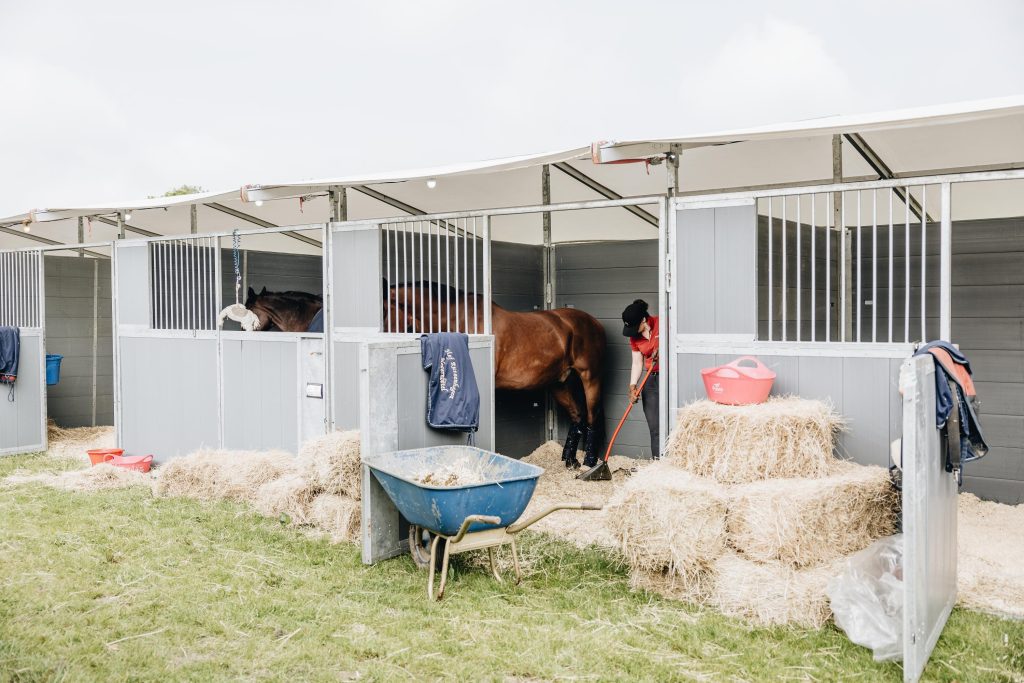Temporary Stabling for Foals and Yearlings: Planning Ahead with Flexibility in Mind
By Dan Hassall, Managing Director, Woodhouse

Foaling stable preparation is more than a winter task. For many professional and private yards, it begins now – well before the first due date.
Foaling might seem a long way off, but for most yards, serious planning begins well before the season does. With early mares already in foal and scanning underway for next year’s crop, summer is often the best opportunity to take stock.
Whether you’re foaling down at home, welcoming bought-in youngstock or yearlings, or balancing infrastructure projects around growing numbers, having the right stabling in place, and the flexibility to adapt, plays a big part in setting the season up for success.
Why Preparation Starts Now
On a well-run yard, planning for next season often starts while this one is still in motion. With seasonal pressures shifting over the summer, many yards find this is the most practical window for foaling stable preparation – time to reflect on what worked, identify potential pinch points, and put plans in place before the pace builds again.
Stabling is central to that conversation.
It’s not just about whether there’s space, but whether the right kind of space is available when and where it’s needed. That might mean adjusting the yard layout, scheduling refurbishment works or factoring in additional units to create flexibility through the early months of the year.
What Makes a Good Foaling and Yearling Environment
The essentials are well understood: ventilation, hygiene, lighting, drainage, and calm surroundings. But as numbers increase or timelines tighten, delivering those consistently can require a more adaptable setup
Some of the features that make a meaningful difference:
- Ventilation without exposure
Winter foalings need shelter but without sacrificing airflow. Poor air quality is a risk even in cold conditions. - Visibility
Lighting matters – not just for checks and foal watch, but for clarity and calmness during intervention. - Space and layout
Larger stables with good access allow teams to handle situations efficiently and safely. - Surfaces and bedding
Rubber matting, good drainage and appropriate bedding all play a part in safeguarding early-stage health and hygiene, especially for foals during their first days and weeks. - Turnout integration
Early turnout routines can shape behaviour and development, and easy access is part of that setup.
Many yards align to welfare guidance from respected organisations such as the British Horse Society and World Horse Welfare, alongside breed-specific or discipline-focused bodies like the Thoroughbred Breeders’ Association, British Eventing Breeding Group, and the FEI. These frameworks are designed to support good practice, but it’s the decisions made at ground level that ultimately shape outcomes.
Whether producing for racing, sport, or sales, now is the time to ensure those welfare principles are fully reflected in the day-to-day setup, from layout and ventilation to flexibility and biosecurity. Your vet or veterinary team also remains a key voice in shaping the right plan for each mare and foal, particularly when early births, specialist care, or intake protocols are involved.
Accommodating Bought-In Foals and Yearlings
For those sourcing foals or weanlings from specialist breeders, creating the right environment to receive them is just as important as preparing for homebred stock. Horses are sensitive to their surroundings, and in those early weeks, stable design, airflow and safe handling access all play a role in helping them settle, stay healthy and develop well.
The same applies to yearlings, particularly those arriving now, through late summer and early autumn, to be brought on, broken in or prepared for sales. As with foals, their first environment on a new yard can influence behaviour, immunity and condition. Having flexible, well-ventilated space available for intake, observation or separation helps ease that transition and maintain high welfare standards during this important phase.
Whether the goal is to produce youngstock for resale or bring on horses to compete, the early environment shapes outcomes. Additional stables can provide breathing room during intake, support quarantine protocols or simply allow for smarter rotation as groups change.

Supporting Biosecurity Without Overcomplicating the Yard
Foaling season brings inevitable movement, with mares returning from stud, youngstock arriving from external breeders, additional staff or vet visits, and, in some cases, emergency interventions. That movement raises risk.
Temporary stabling can help create practical, biosecure zoning, giving teams the ability to separate higher-risk individuals or manage incoming stock without disrupting the day-to-day flow of the main yard. For many, it’s a simple and effective way to maintain standards while keeping operations running smoothly.
Building in Flexibility with Long-Term Hire
The same principles that guide our event temporary stabling apply here – clear ventilation paths, light-filled interiors and durable, hygienic materials that are easy to clean and manage. Every detail is designed to support horse welfare and simplify the day-to-day running of the yard.
Each setup is installed by our experienced team with minimal disruption and ground impact, and adapted to suit your site and your schedule, whether for a foaling unit, a weaning block, or additional seasonal capacity.
Looking Ahead
Foaling season doesn’t just arrive – it builds. And in the pressure of winter, having already made space for what’s coming next can make all the difference.
Whether it’s managing higher numbers, creating calm space during yard improvements, or adding long-term capacity at home, this is a good moment for foaling stable preparation – a change to review what’s in place and consider what might be needed to support the season ahead.
Dan Hassall, Managing Director, Woodhouse